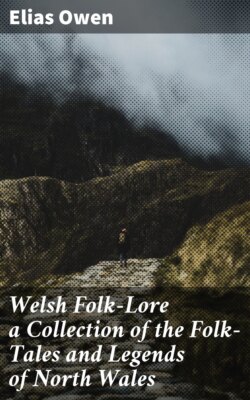Читать книгу Welsh Folk-Lore a Collection of the Folk-Tales and Legends of North Wales - Elias Owen - Страница 9
На сайте Литреса книга снята с продажи.
FAIRY LADIES MARRYING MORTALS.
ОглавлениеTable of Contents
In the mythology of the Greeks, and other nations, gods and goddesses are spoken of as falling in love with human beings, and many an ancient genealogy began with a celestial ancestor. Much the same thing is said of the Fairies. Tradition speaks of them as being enamoured of the inhabitants of this earth, and content, for awhile, to be wedded to mortals. And there are families in Wales who are said to have Fairy blood coursing through their veins, but they are, or were, not so highly esteemed as were the offspring of the gods among the Greeks. The famous physicians of Myddfai, who owed their talent and supposed supernatural knowledge to their Fairy origin, are, however, an exception; for their renown, notwithstanding their parentage, was always great, and increased in greatness, as the rolling years removed them from their traditionary parent, the Fairy lady of the Van Pool.
The Pellings are said to have sprung from a Fairy Mother, and the author of Observations on the Snowdon Mountains states that the best blood in his veins is fairy blood. There are in some parts of Wales reputed descendants on the female side of the Gwylliaid Cochion race; and there are other families among us whom the aged of fifty years ago, with an ominous shake of the head, would say were of Fairy extraction. We are not, therefore, in Wales void of families of doubtful parentage or origin.
All the current tales of men marrying Fairy ladies belong to a class of stories called, technically, Taboo stories. In these tales the lady marries her lover conditionally, and when this condition is broken she deserts husband and children, and hies back to Fairy land.
This kind of tale is current among many people. Max Müller in Chips from a German Workshop, vol. ii, pp. 104–6, records one of these ancient stories, which is found in the Brahmana of the Yagur-veda. Omitting a few particulars, the story is as follows:—
“Urvasi, a kind of Fairy, fell in love with Purûravas, the son of Ida, and when she met him she said, ‘Embrace me three times a day, but never against my will, and let me never see you without your royal garments, for this is the manner of women.’ In this manner she lived with him a long time, and she was with child. Then her former friends, the Gandharvas, said: ‘This Urvasi has now dwelt a long time among mortals; let us see that she come back.’ Now, there was a ewe, with two lambs, tied to the couch of Urvasi and Purûravas, and the Gandharvas stole one of them. Urvasi said: ‘They take away my darling, as if I had lived in a land where there is no hero and no man.’ They stole the second, and she upbraided her husband again. Then Purûravas looked and said: ‘How can that be a land without heroes and men where I am?’ And naked, he sprang up; he thought it too long to put on his dress. Then the Gandharvas sent a flash of lightning, and Urvasi saw her husband naked as by daylight. Then she vanished; ‘I come back,’ she said, and went.
Purûravas bewailed his love in bitter grief. But whilst walking along the border of a lake full of lotus flowers the Fairies were playing there in the water, in the shape of birds, and Urvasi discovered him and said:—
‘That is the man with whom I dwelt so long.’ Then her friends said: ‘Let us appear to him.’ She agreed, and they appeared before him. Then the king recognised her, and said:—
‘Lo! my wife, stay, thou cruel in mind! Let us now exchange some words! Our secrets, if they are not told now, will not bring us back on any later day.’
She replied: ‘What shall I do with thy speech? I am gone like the first of the dawns. Purûravas, go home again, I am hard to be caught, like the wind.’ ”
The Fairy wife by and by relents, and her mortal lover became, by a certain sacrifice, one of the Gandharvas.
This ancient Hindu Fairy tale resembles in many particulars similar tales found in Celtic Folk-Lore, and possibly, the original story, in its main features, existed before the Aryan family had separated. The very words, “I am hard to be caught,” appear in one of the Welsh legends, which shall be hereafter given:—
Nid hawdd fy nala,
I am hard to be caught.
And the scene is similar; in both cases the Fairy ladies are discovered in a lake. The immortal weds the mortal, conditionally, and for awhile the union seems to be a happy one. But, unwittingly, when engaged in an undertaking suggested by, or in agreement with the wife’s wishes, the prohibited thing is done, and the lady vanishes away.
Such are the chief features of these mythical marriages. I will now record like tales that have found a home in several parts of Wales.
